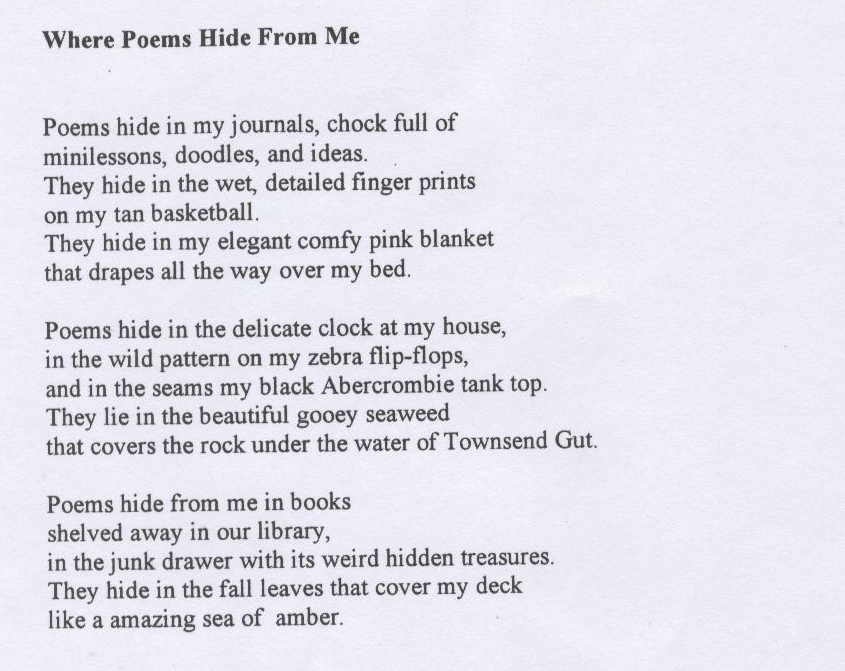2012
SARAH MOOK
POETRY PRIZE RESULTS
3-5 FIRST PLACE
Maggie
Larson
Edgecomb, ME
 |
|
COMMENTS FROM CONTEST JUDGE MARIE KANE: This inventive first place poem expertly uses visual and tactile images to describe the many places where poems hide. This writer chooses innovative hiding places and describes them with finesse. The poem is constructed in three stanzas that are pleasing on the page. The first stanza opens with poems that "hide in my journals, chock full of / minilessons, doodles, and ideas"-a recognizable storage place for poetic ideas. Then, the writer moves to a more personal hiding place and a creative spot where poems hide: "in the wet, detailed finger prints / on my tan basketball." Next, poems are said to hide "in my elegant comfy pink blanket / that drapes all the way over my bed." While the visual is handled well here, note the tactile nature of both of these descriptions; the prints are "wet and detailed" and the bedspread is "comfy." In the next section, poems hide in many detailed and uncommon places. First, they hide "in the delicate clock at my house," and "in the wild patterns of my zebra flip-flops." The well-chosen adjectives, "delicate" and "wild," add to the specifics in the poem and enable the reader to visualize both objects. Next, poems hide in:
These lines have many admirable qualities. First, the specifics of "Abercrombie," and "Townsend Gut," demonstrate that this writer is comfortable using brand names and alluding to the setting of the poem. Most readers would recognize an Abercrombie tank top, but many would have to Google "Townsend Gut," as I did-which is fine. I especially admire the use of the "seams" of the tank top-a particular that gives the poem depth. I like that the writer describes the seaweed as "beautiful and gooey"-an original use of an oxymoron-and tells us that it "covers the rock under the water." The reader is able to vividly picture this rock with its seaweed. To identify it as a place where "poems lie" is not only mysterious, but also alludes to the difficulty, if not impossibility, of retrieving the "poem." Also notice the rhythm of "covers the rock under the water"--a pleasing sound indeed. In
the last section, the poet moves back to his or her home to describe
the places that poems hide. I thoroughly enjoyed this writer's imagination, ability to use captivating and specific descriptions, and use of control and detail in writing the poem. Thank you for the privilege of reading your work! Marie
Kane, Final Judge, Sarah Mook Poetry Contest |